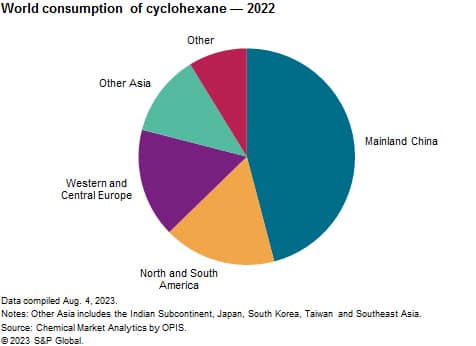Published September 2023
Nearly all cyclohexane is used to make cyclohexanol and cyclohexanone, which, in turn, are used mainly as precursors for the production of adipic acid and caprolactam, respectively. Other uses for cyclohexane include various solvent applications and the production of cyclohexanol and cyclohexanone for solvent use. As a result of cyclohexane’s intrinsic link to the polyamide (nylon) chain and its use in automobiles, construction and textiles, global cyclohexane demand remains strongly influenced by macroeconomic conditions. Cyclohexane is consumed largely for nylon 6 fibers, resins and film.
The following pie chart shows world consumption of cyclohexane:

Over the past five years, most regions experienced flat or declining demand for cyclohexane, but mainland China has been the epicenter of demand growth. Mainland China’s capacity has increased significantly in recent years, propelled primarily by growth in caprolactam demand for nylon 6. The global market for cyclohexane is oversupplied at present and is expected to remain so through the forecast period.
For more detailed information, see the table of contents, shown below.
S&P Global’s Chemical Economics Handbook – Cyclohexane is the comprehensive and trusted guide for anyone seeking information on this industry. This latest report details global and regional information, including:

S&P Global’s Chemical Economics Handbook – Cyclohexane has been compiled using primary interviews with key suppliers and organizations and leading representatives from the industry, in combination with S&P Global’s unparalleled access to upstream and downstream market intelligence and expert insights into industry dynamics, trade and economics.
This report can help you
- Identify trends and driving forces influencing chemical markets
- Forecast and plan for future demand
- Understand the impact of competing materials
- Identify and evaluate potential customers and competitors
- Evaluate producers
- Track changing prices and trade movements
- Analyze the impact of feedstocks, regulations, and other factors on chemical profitability


















